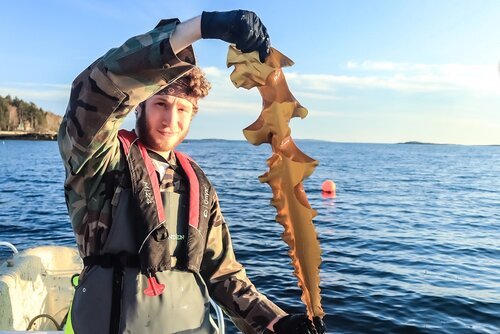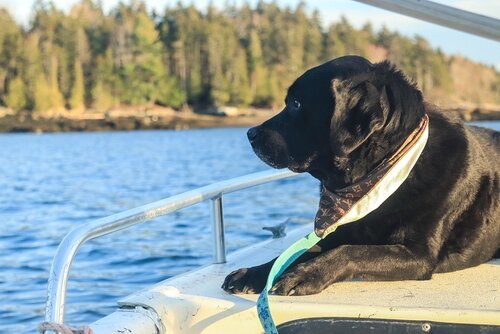The Story of a Maine Seaweed Farm: An Evening Harvesting Sugar Kelp with Ridley Cove
I enjoyed an amazing evening harvesting Sugar Kelp (Saccharina Latissima) with Ridley Cove Kelp owner Isaac Burtis, and learning the process for growing Maine's up-and-coming superfood: seaweed.
Twilight fell quickly in Ridley Cove. There were just a few moments where the waters reflected the glowing streaks of orange and magenta, before the brooding shades of eventide set in. Before the sun dipped beneath the cold ocean waters, the entirety of Ridley Cove seemed to glimmer with sunlight, from the trees, to the boats, to the seaweed. In fact, I had no idea how beautiful seaweed could look with the sunset reflecting its spectrum of colors off of its leaf-like blades.
Isaac Burtis, the owner of Ridley Cove Kelp, took a pause from neatly folding blades of kelp that had just been plucked from a hanging line of rope to marvel at the sunset. Isaac was fixated on the sunset, but I was gawking at the massive ruffled blade of sugar kelp he was still holding that tumbled down almost six feet. Not only was this my first tour of a kelp farm, but it was during the yearly harvest, when the kelp was at its longest. Isaac’s kelp resembled caramel-colored Christmas ribbon candy – crimped, crinkled, and a perfect amber color. Still focused on the sunset, Isaac continued to fold the kelp several times before neatly placing it onto a stack of other blades prepared for market.
Every year, during the last week in April, Maine kelp farmers flock to their farms to harvest their crop. Kelp flourishes quickly in the Gulf of Maine, oftentimes growing ten feet between December, when the kelp is first seeded, and April, when it is harvested. During the summer months when the coastal waters warm, kelp growth slows, but the populations of other sea-dwelling microorganisms, which have the potential to foul the kelp, rises. Thus, the spring waters teem with farmers, like Isaac, plucking pounds upon pounds of seaweed for market.
Seaweed has been hailed as Maine’s up-and-coming superfood. In fact, Maine is the country’s number one producer of seaweed. The Gulf of Maine boasts over 250 species of seaweed, eleven of which are commercially harvested. Not only are the health benefits of kelp and other seaweeds astronomical, but sea vegetables provide other environmental and economic benefits. For one, as seaweed grows, it absorbs carbon dioxide from the water during the photosynthesis process, which works to mitigate the effects of ocean acidification. Second, kelp is a winter crop, and has a complementary seasonal cycle to many finfish, lobsters, and oysters. At a time when Maine’s traditional waterfront jobs face multiple pressures and uncertainties, lobstermen and other fishermen are turning to aquaculture, including kelp farming, to diversify their income.
The Origin of Ridley Cove Kelp
Isaac Burtis, a Senior at Brunswick High School, was always interested in starting a small business that allowed him to work on the water, and create something that was beneficial to the marine ecosystem. Isaac spent his summers digging clams from the local mudflats to sell to local wholesalers to build his finances. His father and older brother own Ferda Farms, LLC, an oyster farm taking up residence on the New Meadows River. Inspired by Ferda Farms’ quick success and commitment to sustainability, Isaac sought to make his own mark on the Maine Aquaculture community.
“I thought kelp farming would be a good fit for me – it’s a great crop for someone first getting into aquaculture, and it helps create a healthy marine environment,” Isaac explained to me earlier in the day, as we journeyed from his home in Brunswick to the Bethel Point town boat launch. “I also really wanted to get into the seaweed industry as it was exploding here in Maine.”
In Maine, farmers must apply for aquaculture leases from the Department of Marine Resources to grow and harvest seaweed. The number of individuals applying for leases has exploded over the past five years due in combination to the national attention seaweed has been receiving on both foodie and environmental fronts, as well as to the relative ease of incorporating seaweed into an existing marine business, such as oyster farming. Many oyster farmers found that they could use the same lease site to grow oysters in warm months, and turn to seaweed in the cooler months while the oysters were over-wintering. Even more impressive, the amount of kelp being harvested off of Maine’s coast, and the harvest value, has grown almost five times in only one year, between 2018 and 2019. Isaac saw his opportunity to be a part of a close network of kelp farmers who sought to ride out the waves of the industry boom.
Choosing a Home for a Kelp Farm
Earlier that day, Isaac, his father, Chris, and I departed from the Bethel Point boat launch in Cundy’s Harbor just as the tide was beginning to ebb towards the sea. Isaac’s 800-foot lease site in Ridley Cove is a quick ten minute jaunt from the launch. There, protected by the coastlines of Yarmouth Island to the West and the southern tip of Harpswell to the East, the waters of Ridley Cove are deep and serene. However, there was a lot more that went into Isaac’s choice of a site beyond a gorgeous view. Before committing to a lease site, Isaac did his homework to determine a location that would be optimal for growing kelp. While kelp will naturally adapt to the environment in which it grows, there are certain conditions in which it thrives.
“Kelp grows best in areas with deep channels, sufficient wave action, but gentle tides” Isaac explained, as he slowed the boat as we approached several peach buoys labeled “sea farm.” His goal was to choose a site with sufficient depth and a strong waves, as the churning waters would bring his kelp adequate nutrients for growth. The deep waters would lessen the chance of his growing kelp from touching the seafloor, and, in turn, reduce the amount of biofouling, and lessen the chance of predators, such as urchins, from harming the seaweed. At the same time, Isaac wanted to avoid a location with substantial tides and ice flows in order to reduce the wear-and-tear on his farm. Further, Isaac needed to search for a site with cold, pristine waters—something not too hard to come by in Maine.
Upon deciding he wanted to fully invest in his kelp operation, Isaac dove in headfirst to learn the ins-and-outs of successfully farming seaweed in Maine. He had numerous meetings with Jaclyn Robidoux, a seaweed specialist and member of the Maine Sea Grant Marine Extension Team who taught Isaac the science behind a successful seaweed operation. Isaac also spent time working alongside Colleen Franckes, the founder of Maine Kelp Ladies, a seafood company harvesting kelp in Casco Bay.
“Going through the process of actually seeding a line of kelp with an experienced farmer gave me the confidence to try kelp farming myself. Plus, the materials and knowledge I gained from having conversations with other kelp farmers prepared me to speak to a number of harbormasters about potential locations,” Isaac explained. With a little bit of experience under his belt, Isaac proceeded with completing the paperwork necessary to obtain his first kelp lease site in Ridley Cove.
Choosing a Seaweed
Once we had arrived at the lease site, I peered over the boat edge and immediately saw a forest of golden kelp ribbons swaying underwater against the cerulean seas. The golden crinkles seemed to go on endlessly beneath the water. Isaac dipped his hand into the water, pulled up a strand of a crimped ribbon of sugar kelp, and handed it to me .The surface of the kelp was slick, and crunched as I bent and folded the piece in my hand.
Kelp (Asophyllum nodosum) is among the largest varieties of cold-water species of seaweed. It grows underwater in shallow, nutrient-rich coastal saltwater beds around the world. Kelps have unique physiological properties that allow them to survive under ice, in near-darkness, and in high-energy environments. Furthermore, kelps are subtidal, and therefore must be harvested at extremely low tide. Adult individuals can reach, on average, 10-15 feet, forming forest-like environments suspended above the ocean floor. Many of Maine’s kelp farms grow either Sugar Kelp (Saccharina Latissima), Winged Kelp (Alaria esculenta), or Skinny Kelp (Saccharina latissima forma angustissima). Other seaweed species, such as Dulse, Kombu, Bladderwrack, and Irish Moss, are other varieties gaining momentum.
Currently, Ridley Cove Kelp grows Sugar Kelp, a brown algae. Sugar Kelp gets its name from the sweet white powder (mannitol) that comes to the surface as the seaweed dries. Sugar kelp has a long ribbon-like blade on a short thin stipe, which attaches to the frond (or stalk) housing the remainder of the plant. This long, wide blade is crinkled throughout and gives the seaweed its nickname the Sea Belt. The short stipe is very flexible so that it bends and keeps the frond of blades submerged in shallow water to prevent it from drying out on low tides. After a first successful year of operations, Isaac noted he hopes to add Skinny Kelp to diversify his farm next year.
Perhaps the most noticeable thing about Ridley Cove’s Sugar Kelp was the individual blades were massively large. Isaac explained to me that the four-to-five-foot pieces of kelp he was pulling from the water were only four months old. Sugar Kelp is revered for being a fast-growing winter crop that thrives in cold environments. Isaac and one of his friends seeded his entire farm on Christmas Eve of 2019. By late-April, the kelp had grown to full adult size, and were ready for harvest.
Isaac worked to dredge his kelp line and hook it to his boat’s hoist. As the sun began its descent, he began cranking his line. Slowly, a massive line of kelp began to emerge through the water’s surface. The sun’s rays hit the line of kelp, causing the array of gold and brown hues to glisten. Sugar Kelp is typically grown on a horizontal line submerged beneath the water’s surface. The goal is to grown the kelp at a depth where it can still obtain sufficient sunlight to grow. Growing sugar kelp requires no feed – sugar kelp produces their own food through photosynthesis, using sunlight, carbon dioxide, and water.
Isaac explained to me that one of the very first steps in beginning his kelp farm was seeding the lines of rope that would become the foundation of his farm. He did this by purchasing spools of line that were braided with kelp seed cultivated by the team at Atlantic Sea Farms in partnership with Bigelow Laboratories. Kelp seed is prepared in laboratories for kelp farmers by placing a “seed string” in a culture tank filled with seaweed spores. The spores attach to the string, and begin to grow into kelp seed. Kelp farmers purchase spools of this string, and thread lines of rope through a spool of seeded string. They then reverse their boats, and the seed string unwinds around the rope. The rope remains submerged in the water, tied to moorings on opposite ends of the lease site. In no time, the kelp begins growing exponentially.
As the line of kelp dangled out of the water, Isaac began carefully inspecting the blades. “In the winter, I go to my farm every one to two weeks to check on my crop, to make sure that blades all look healthy, and there isn’t any biofouling,” Isaac spoke, as he flipped through the kelp. “Plus, I take measurements of the water quality, and test the dissolved oxygen, salinity, pH, and temperature.”
The Harvest
Isaac plucked a number of lengthy blades and folded them into biodegradable containers to be sold to individual consumers. Each year, at the end of April, Maine celebrates Seaweed Week – a food celebration meant to commemorate the yearly seaweed harvest. During this week, many of Maine’s top chefs, mixologists, brewers, and distilleries feature native seagreens on their menu. This year, due to current world events, Maine Seaweed Week took on a virtual celebration, which chefs and seaweed experts alike sharing their favorite ways to incorporate seaweed into daily meals.
“Next year, when restaurants re-open, I’ll also be able to sell to restaurants and distributors in addition to my current direct-to-customer market,” Isaac explained. Presently, Maine seaweed farmers are pairing with oyster farmers to distribute their crops locally to consumers. Many farmers also work directly with industry giants, such as Atlantic Sea Farms, to sell their crops to be transformed into seaweed products, such as food products, condiments, animal feed, fertilizer, and even beauty products.
Isaac finished boxing the last of his orders as the last watercolor splashes of oranges and magentas began to fade from the sky. Isaac carefully reverse-cranked his kelp line back into the cold ocean for the evening. As we began our slow cruise back to the boat launch, Isaac shared his plans for Ridley Cove Kelp’s future. “My goal is to merge my farm with my father and brother’s oyster farm,” Isaac explained, as we approached the dock. “Because seaweed sequesters carbon, and creates oxygen, this would have a directly positive effect on the surrounding oysters, and help them strengthen their shells.”
Isaac sent me home with a massive container of his geometrically ruffled amber-colored sugar kelp. That night, as I sat in my kitchen, editing photographs of the day’s harvest, I ladled myself a cup of broth I simmered using kelp, mushrooms, turmeric, and ginger. The first sips brought a savory umami flavor, with a second wave of subtle earthy sweetness. With a crop that is good for the environment, and downright delicious, the Maine seaweed boom makes perfect sense. Now is the time to sit back and watch as the industry flourishes.









